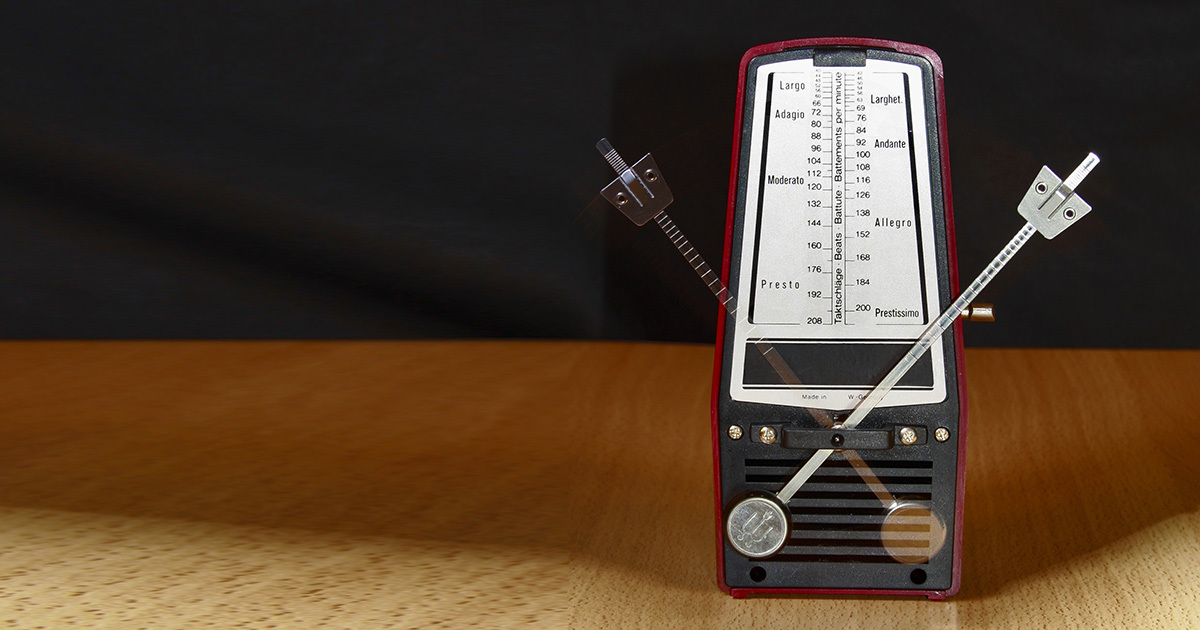The Metronome: A Musician's Best Friend
by Andrew J. Allen
Date Posted: January 02, 2019

What if I told you there was a magical device that could help you quickly and easily improve your time, technique, and even your sound, and it could be bought for a few dollars or less? Would you take full advantage of it? Such a device does exist: The metronome! Today, an excellent one can be accessed through a smartphone for little to no money. With it, many common problems and challenges can be overcome, if you know how to use it!
Too often, young musicians do not recognize how vital a metronome is. They may not know how to use it properly, or may become quickly frustrated when technique does not line up perfectly with it from the start. However, consistent use of a metronome is a vital component of organizing efficient and successful practice.
To begin with, for any difficult piece of technique, repeating the passage, repeating it, and repeating it with mistakes will never yield the best results. Rather, that method just increases the likelihood of errors in performance. The goal should be to learn a piece of music correctly from the beginning, minimizing problems along the way.
"...consistent use of a metronome is a vital component of organizing efficient and successful practice." - Andrew J. Allen
To learn a passage with few to no mistakes, a few things are necessary. First, the student must be comfortable with a counting system. For both basic and familiar rhythms, the student should be able to sound them out, in time, without the instrument. The old saying, “If you can count it, you can play it,” holds true.
Even at the counting stage, a metronome is vital. For difficult rhythms, set the metronome back many clicks (thirty, forty, fifty, or more) from the goal tempo. It will be much easier to count these tough rhythms at slow tempos. Then, gradually, build up by small increments (three or four “clicks” at a time). Do not speed up until the rhythm is consistently clean and comfortable at the present tempo. Before long, the rhythm will ingrained in the student so that they can then focus more on the element of technique.
When approaching a difficult passage on the clarinet or saxophone, the metronome is just as valuable. For any difficult passage, it is advisable to find a tempo low enough that the technique can be played accurately and in-time from the start. Avoiding mistakes early on will make the learning process much easier! Start at a very low tempo: Even for a passage at Allegro, if it is difficult, perhaps setting the metronome to forty beats per minute, or even less, will be necessary. If the piece is difficult enough, it may even be wise to set the beat to the eighth note at a low tempo.
From the start, small chunks that are easily digestible should be practiced: A phrase or less at a time for difficult technique. Perfection should be the goal, with all articulations, dynamics, and other musical considerations included from the very beginning. Also, just as important, all of this should be achievable with a relaxed body. Any tension or any inability to perform all aspects of the music accurately mean that the metronome should be turned to a slower setting.
As with the counting exercise, the passage should be played consistently, correctly, and comfortably before the tempo is moved up. Perhaps three or four such performances in a row are necessary before moving the metronome up any. If a mistake is made before the assigned number of repetitions, the student must start over again. If it is very difficult to perform the passage correctly more than once in a row, dial the metronome back by a few notches.
"A great final product is achieved far more quickly and with less stress than simply repeating, repeating, and repeating..." - Andrew J. Allen
Once comfort is achieved, the metronome should only be adjusted up by very small increments at a time: Again, perhaps three or four “clicks.” The goal is to notice the change in tempo as little as possible: The technique should still be fairly easy to perform with all musical elements, in a relaxed manner. While all of the above may sound like it would take a long time, it does not. A great final product is achieved far more quickly and with less stress than simply repeating, repeating, and repeating a passage without disciplined use of the metronome.
Along with being the best way to work on technique, consistent use of the metronome can aid many basic aspects of performance. For saxophonists, vibrato can most effectively be learned and improved with the use of the metronome. Articulation speed and accuracy exercises are only made more effective with consistent use of the metronome and slow tempo growth. The jazz player’s time and feel can be improved greatly by consistently practicing with a metronome. The list goes on and on: To grow as effectively and as much as possible, the metronome is the musician’s best friend!
Subscribe to the We Are Vandoren E-newsletter (WAVE) to receive 4 weekly articles for Performers, Students, and Educators